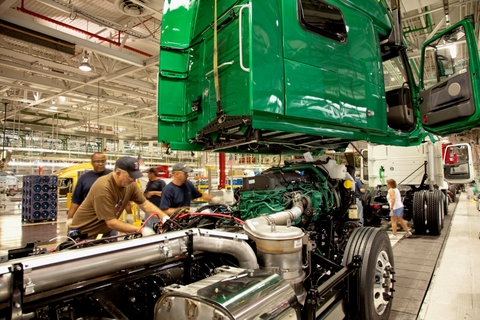Truck and trailer orders normalizing, not crashing: FTR
INDIANAPOLIS, Ind. – Class 8 truck orders have fallen sharply in recent months, but FTR forecasters aren’t sounding any alarms, and say the drop marks a return to more normal levels.
Eric Starks, CEO of FTR, also chalked the decline up to uncertainty stemming from the trade war with China and other political issues.
“When you’re a business decision-maker trying to decide, ‘What should I be doing?,’ when that uncertainty enters, you say ‘I’m not doing anything’,” Starks said.
While manufacturing is flat, the data doesn’t reflect a recessionary environment, but rather a correction, Starks said. And consumer spending remains strong. FTR’s tracking of monthly freight loadings has flattened out, but there’s no downward spiral that should spark concern, Starks noted.
“The market continues to be relatively healthy,” he said. “We are seeing a normalization within the market.”
The spot market has seen rate declines, but remains relatively healthy, and above the five-year average, Starks pointed out. FTR is projecting freight growth of 1% to 1.5% through the balance of this year and next.
Don Ake, vice-president of commercial vehicles for FTR, reiterated that the Class 8 truck market is coming off some tremendous years; four of the top seven production years ever have occurred within the past six years. The Class 8 production rate this year is forecast to reach 353,000 units, compared to 323,500 last year. The all-time record was 2006, when 371,000 trucks were built, aided by the EPA07 emissions pre-buy.
But there’s no hiding the fact Class 8 orders have plunged since the highs set in the fourth quarter of 2018.
“If looked at in a vacuum, you’d think things are horrible,” Ake admitted. However, he noted if the 2018 and 2019 monthly order numbers were to be averaged out, they’d still come in above the seven-year average.
“The market is trying to get back to normal,” said Ake. And he’s also encouraged by the fact there’s been no spike in cancellations. “I thought once we got into mid this year, we would see cancellations spike. What we saw was cancellations increase, but not spike. (Customers) are taking most of these trucks, which is a very good sign for the market. It’s a normalization of the market, not a crash of the market.”
Class 8 retail sales and build rates also remain strong, but Ake said most OEMs have announced build rate slowdowns. Backlogs are being drawn down, but remain at historically high levels. Ake said October will be an important month for orders. It’s reasonable to expect 20,000 Class 8 orders a month in the coming months, Starks said. Truck inventories are high, meaning retail sales will need to pick up to prevent unhealthy inventories for dealers.
FTR’s forecast for 2020 heavy truck production for the US, Canada and Mexico are 260,000 units in 2020, 255,000 units in 2021, and 245,000 units in 2022. However, Ake admitted it’s a “slightly optimistic” forecast. “We don’t see the market crashing, as long as GDP stays up,” he said.
Starks added 245,000 units is about equal to replacement demand.
Trailer forecast
Forecasting trailer demand is a trickier business, Ake said, especially coming off record years.
“Trailer forecasting is tough and forecasting trailers in 2020 is enormously difficult,” he said. “You thought the truck market was great over the last few years, the trailer market was even better. Five of the top eight trailer production years occurred in this cycle.”
There were a number of variables driving strong demand for trailers, including pent-up demand (many carriers hadn’t refreshed their trailer fleets since the Great Recession). Other factors include: an increase in drop-and-hook operations to get drivers home more often; consumer demand for faster deliveries of a greater variety of foods, increasing refrigerated van demand; an increase in temperature-controlled freight; a more widespread use of dry vans for storage; and even Amazon building its own fleet, rumored to amount to 25,000 trailers this year alone. Ake is anticipating some weakening in the trailer market over the third and fourth quarter.
He is predicting U.S. factory shipments of 326,000 units this year – a new record, 275,000 units next year, 260,000 units in 2021, 265,000 units in 2022 and a bounce-back to 280,000 units in 2023.
“If we get some weakness in the economy, then forget about 260,000 to 265,000 – it will go much lower,” he warned.
For the Canadian market, Ake sees 19,700 trailers shipped this year and 19,500 next year.
What are fleets thinking?
Chris Kemmer, head of CK Commercial Vehicle Research, presented findings from her Fleet Sentiment Report, which surveys 50 people representing fleets running from 25 to 500 Class 8 trucks, on their buying intentions.
“Those types of fleets control about 40% of the Class 8 vehicles out in the universe,” she said.
Only 12.8% of the fleets surveyed in August reported they need more equipment, compared to 36.4% who said they did so in Q2 2018.
Of the fleets surveyed, 80% said they plan to order new trucks in 2020, with an average buying intention representing 13% of their current fleet population. But only about half of the fleets surveyed said they’re planning to buy trailers next year, representing an average of 10% of their current trailer population.
Kemmer said the survey reflected a “primarily positive outlook for 2020,” but “fairly soft equipment purchasing plans.”
Have your say
This is a moderated forum. Comments will no longer be published unless they are accompanied by a first and last name and a verifiable email address. (Today's Trucking will not publish or share the email address.) Profane language and content deemed to be libelous, racist, or threatening in nature will not be published under any circumstances.